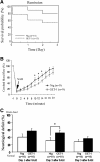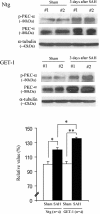Targeted over-expression of endothelin-1 in astrocytes leads to more severe brain damage and vasospasm after subarachnoid hemorrhage
- PMID: 24156724
- PMCID: PMC3815232
- DOI: 10.1186/1471-2202-14-131
Targeted over-expression of endothelin-1 in astrocytes leads to more severe brain damage and vasospasm after subarachnoid hemorrhage
Abstract
Background: Endothelin-1 (ET-1) is a potent vasoconstrictor, and astrocytic ET-1 is reported to play a role in the pathogenesis of cerebral ischemic injury and cytotoxic edema. However, it is still unknown whether astrocytic ET-1 also contributes to vasogenic edema and vasospasm during subarachnoid hemorrhage (SAH). In the present study, transgenic mice with astrocytic endothelin-1 over-expression (GET-1 mice) were used to investigate the pathophysiological role of ET-1 in SAH pathogenesis.
Results: The GET-1 mice experienced a higher mortality rate and significantly more severe neurological deficits, blood-brain barrier breakdown and vasogenic edema compared to the non-transgenic (Ntg) mice following SAH. Oral administration of vasopressin V1a receptor antagonist, SR 49059, significantly reduced the cerebral water content in the GET-1 mice. Furthermore, the GET-1 mice showed significantly more pronounced middle cerebral arterial (MCA) constriction after SAH. Immunocytochemical analysis showed that the calcium-activated potassium channels and the phospho-eNOS were significantly downregulated, whereas PKC-α expression was significantly upregulated in the MCA of the GET-1 mice when compared to Ntg mice after SAH. Administration of ABT-627 (ETA receptor antagonist) significantly down-regulated PKC-α expression in the MCA of the GET-1 mice following SAH.
Conclusions: The present study suggests that astrocytic ET-1 involves in SAH-induced cerebral injury, edema and vasospasm, through ETA receptor and PKC-mediated potassium channel dysfunction. Administration of ABT-627 (ETA receptor antagonist) and SR 49059 (vasopressin V1a receptor antagonist) resulted in amelioration of edema and vasospasm in mice following SAH. These data provide a strong rationale to investigate SR 49059 and ABT-627 as therapeutic drugs for the treatment of SAH patients.
Figures






References
-
- Macdonald RL. Pathophysiology and molecular genetics of vasospasm. Acta Neurochir Suppl. 2001;77:7–11. - PubMed
-
- Liu X, Nakayama S, Amiry-Moghaddam M, Ottersen OP, Bhardwaj A. Arginine-vasopressin V1 but not V2 receptor antagonism modulates infarct volume, brain water content, and aquaporin-4 expression following experimental stroke. Neurocrit Care. 2010;12(1):124–131. doi: 10.1007/s12028-009-9277-x. - DOI - PubMed
Publication types
MeSH terms
Substances
LinkOut - more resources
Full Text Sources
Other Literature Sources
Research Materials

